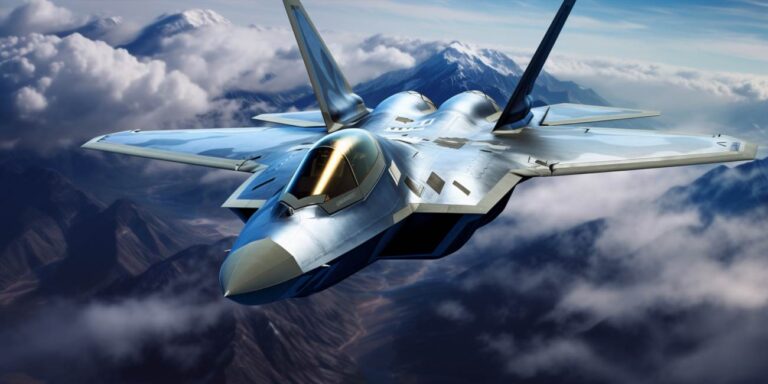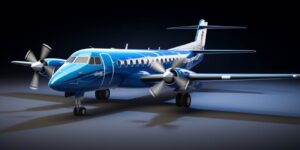Let’s first explore the aspect of speed, a defining characteristic that elevates certain aircraft to a league of their own. The F-22 Raptor stands out as a prime example. This fifth-generation fighter jet is unparalleled in its velocity, capable of reaching Mach 2.25, or more than twice the speed of sound. The blend of advanced aerodynamics and powerful engines propels the F-22 to extraordinary velocities, making it a speed demon in the skies.
Turning our attention to size, the Stratolaunch takes center stage. In the realm of sheer dimensions, this colossal aircraft dwarfs its counterparts. Boasting a wingspan of 385 feet, the Stratolaunch is a true giant. Originally designed as a mobile launch platform for rockets, its enormous size enables it to carry substantial payloads, redefining the possibilities of aerial operations on a grand scale.
Now, let’s delve into the domain of armaments, where firepower becomes the ultimate measure of a military aircraft’s might. The B-2 Spirit, commonly known as the Stealth Bomber, emerges as an epitome of destructive capability. Armed with a variety of munitions, including precision-guided bombs, the B-2 can deliver a devastating payload with unmatched accuracy. Its stealth features further enhance its lethality by allowing it to operate undetected in hostile airspace.
Combining these elements, it becomes evident that the definition of what is the most powerful aircraft is multifaceted. A true contender for this title would need to balance exceptional speed, colossal size, and formidable armaments. As aviation technology continues to evolve, new contenders may emerge, each pushing the boundaries of what is considered possible in the realm of aerial dominance.
The tremendous size and power of the antonov an-225 strategic airlifter plane
The Antonov An-225 strategic airlifter plane stands as a colossal testament to human engineering and aviation prowess. With a wingspan of 88.4 meters and a length of 84 meters, this aerial giant is the world’s largest cargo aircraft, dwarfing its competitors in both size and capacity. The mere sight of the An-225 on the runway commands attention, evoking a sense of awe and admiration.
What truly sets the An-225 apart is its payload capacity, an astonishing 640 metric tons. This unparalleled capability makes it the go-to aircraft for transporting massive and oversized cargo that other planes simply cannot accommodate. The cargo hold of the An-225 is a cavernous space, providing a vital lifeline for industries requiring the movement of colossal equipment, including components for space missions and energy infrastructure.
The powerhouse engines of the Antonov An-225 are no less impressive. Six Progress D-18T turbofans propel this mammoth aircraft, delivering a combined thrust of 300,000 pounds. This immense power allows the An-225 to cruise at speeds of up to 850 kilometers per hour and achieve a range of 15,400 kilometers. Such capabilities make it a strategic asset in global logistics, capable of traversing vast distances with heavy payloads efficiently.
Designed in the 1980s in the Soviet Union to carry the Buran spaceplane, the An-225 has since become a symbol of both technological prowess and adaptability. Its ability to carry various types of cargo, from oversized machinery to humanitarian aid, highlights its versatility in serving diverse needs across the globe.
One cannot discuss the An-225 without acknowledging its iconic twin tail, a distinctive feature that contributes to its stability and control during flight. The aircraft’s design incorporates advanced aerodynamics to manage its colossal size effectively, ensuring a smooth and secure journey through the skies.
Operated by Antonov Airlines, the An-225 remains a rare sight, with only one unit ever built. Its exclusivity adds to its mystique, and the aircraft often draws crowds wherever it lands. The An-225 is not merely a machine; it is a symbol of human ingenuity pushing the boundaries of what is possible in the realm of aviation.
The incredible speed and maneuverability of the lockheed sr-71 blackbird spy plane
The Lockheed SR-71 Blackbird stands as an epitome of aerospace engineering brilliance, setting a benchmark in the realm of fast, rapid, swift, speedy, and quick reconnaissance aircraft. The remarkable speed and maneuverability of this spy plane are nothing short of awe-inspiring.
The SR-71 earned its reputation as the fastest aircraft ever built, capable of reaching speeds exceeding 3,500 kilometers per hour. This extraordinary velocity was crucial for evading enemy threats and swiftly gathering intelligence over vast territories. The aircraft’s sleek design, featuring a long fuselage and forward-swept wings, contributed to its exceptional speed.
One of the key elements enabling the Blackbird’s unmatched speed was its innovative engines. Powered by dual Pratt & Whitney J58 engines, the SR-71 utilized a unique hybrid system that combined a turbojet for takeoff and low-speed operation with a ramjet for high-speed flight. This cutting-edge propulsion technology allowed the aircraft to achieve its phenomenal rapid speeds.
The Blackbird’s maneuverability was equally impressive, especially considering its astonishing speed. The aircraft could perform rapid altitude changes and sharp turns, making it elusive and challenging for enemy defenses to track. Its quick response to pilot commands and advanced avionics systems provided the crew with a high level of control, even at the incredible speeds it achieved.
The SR-71’s reconnaissance capabilities were enhanced by its ability to cover vast distances in a remarkably swift manner. This allowed the aircraft to collect intelligence over extensive territories within a short timeframe, providing invaluable information to intelligence agencies.
Despite its incredible speed, the Blackbird’s design also prioritized stealth and survivability. Its sleek black coating, composed of a special radar-absorbing material, helped minimize its radar cross-section, reducing the likelihood of detection by enemy radar systems during high-speed operations.
The advanced weapon systems on the sukhoi su-57 fighter jet
The Sukhoi Su-57 stands at the forefront of cutting-edge fighter jet technology, boasting an impressive array of missiles, armaments, and weapons. This fifth-generation aircraft is a true marvel in the world of artillery and arms, seamlessly integrating advanced systems to ensure superiority in the skies.
One of the key highlights of the Su-57 is its use of the hypersonic missile system. This state-of-the-art weaponry enables the jet to engage targets at unprecedented speeds, outpacing conventional defense systems. The integration of hypersonic missiles elevates the Su-57’s lethality and strategic capabilities, providing a decisive edge in modern aerial warfare.
The armaments onboard the Su-57 include a versatile suite of precision-guided munitions. Equipped with smart bombs and cruise missiles, this fighter jet is designed for surgical precision in striking ground targets. The weaponry options ensure adaptability in various mission scenarios, ranging from anti-aircraft operations to ground-based missions.
Stealth technology is a cornerstone of the Su-57’s design, offering enhanced survivability and a reduced radar cross-section. This feature, coupled with the integration of long-range air-to-air missiles, allows the jet to engage adversaries from a considerable distance. The Su-57’s missile systems are not only lethal but also reflect a strategic emphasis on maintaining a tactical advantage in aerial engagements.
Furthermore, the Su-57 is equipped with a cutting-edge electronic warfare suite, enhancing its ability to disrupt and neutralize enemy systems. This electronic warfare capability is seamlessly integrated into the aircraft’s defensive and offensive operations, creating a layered defense against incoming threats. The synergy between advanced arms and electronic warfare establishes the Su-57 as a formidable force in contested airspace.
Table: Key Weapon Systems on the Sukhoi Su-57
| Missile Systems | Hypersonic Missiles, Long-Range Air-to-Air Missiles |
| Armaments | Smart Bombs, Cruise Missiles |
| Electronic Warfare | Advanced Electronic Warfare Suite |






